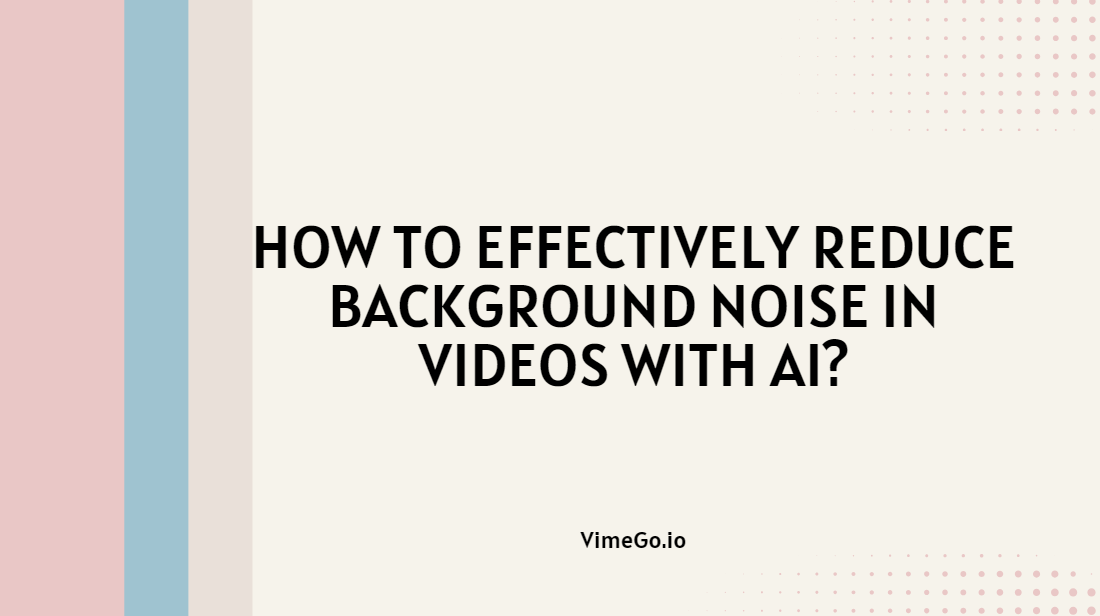How to Effectively Reduce Background Noise in Videos with AI?

In the age of digital content creation, the quality of your video is of utmost importance. While many creators focus on visuals and storytelling, one crucial aspect often gets overlooked: audio quality. Background noise can significantly detract from the overall viewing experience.
Fortunately, advancements in artificial intelligence (AI) are making it easier than ever to reduce or eliminate background noise in videos. In this blog post, we will explore what background noise is, why it should be removed, how to effectively reduce it, and tips for preventing it during recording.
What is “Background Noise”?
Background noise refers to any unwanted ambient sound that interferes with the primary audio in a video or audio recording. This can include sounds like traffic, wind, chatter, electronic hums, or any other sound that isn’t part of the intended audio. Background noise can be particularly problematic in various contexts, such as interviews, podcasts, vlogs, or any content where clear audio is critical.
In technical terms, background noise can be categorized into two types: continuous noise and impulsive noise. Continuous noise is steady and persistent, such as the sound of a fan or air conditioning. Impulsive noise, on the other hand, is sudden and sporadic, like a door slamming or a dog barking. Both types can be distracting and can make it challenging for viewers to focus on the content at hand.
Why Should I Remove Background Noise From Video or Audio?
There are several compelling reasons to consider removing background noise from your video or audio recordings:
- Improved Clarity: Background noise can obscure dialogue and important audio elements, making it difficult for viewers to understand the content. By eliminating this noise, you enhance the clarity and intelligibility of your audio.
- Professionalism: High-quality audio is a hallmark of professional content. Viewers are more likely to engage with and trust videos that have clear sound. On the contrary, videos with distracting background noise may be perceived as less polished and unprofessional.
- Enhanced Viewer Experience: A clean audio track allows viewers to immerse themselves in the content without distractions. This can lead to increased viewer retention and satisfaction.
- Accessibility: For individuals with hearing impairments, background noise can make it even more challenging to follow along with the audio. By reducing background noise, you create a more accessible experience for all viewers.
- SEO Benefits: Search engines and video platforms increasingly prioritize content quality. Videos with clear audio are more likely to rank higher in searches, helping you reach a broader audience.
How to Remove Background Noise From Video?
With the advent of AI technology, removing background noise has become more accessible and efficient. Here are some effective ways to achieve this:
AI-Powered Software
One of the most effective methods for reducing background noise is to use AI-powered software. Many modern video editing and audio processing tools come equipped with machine learning algorithms that can intelligently distinguish between desired audio (like dialogue) and unwanted background noise.
Examples include:
VimeGo: Supports free online removal of background noise, compatible with various devices. After removing the noise, you can download it locally at any time.
Adobe Audition: This professional audio editing software includes a “DeNoise” effect that uses AI to identify and reduce background noise without affecting the quality of the primary audio.
Descript: This tool not only offers noise reduction but also allows you to edit audio by editing text, making it user-friendly for non-audio professionals.
iZotope RX: Known for its advanced audio repair capabilities, iZotope RX uses AI to analyze audio and remove unwanted noise while preserving the clarity of the main audio track.
Manual Noise Reduction Techniques
If you prefer a hands-on approach, you can also reduce background noise manually using various audio editing techniques:
- Equalization (EQ): By adjusting the frequency levels of your audio, you can reduce certain frequency ranges where noise is prominent. For instance, if there’s a hum at a specific frequency, lowering that frequency can minimize its impact.
- Noise Gates: A noise gate allows audio to pass through only when it exceeds a certain volume threshold. This can be useful for eliminating low-level background noise during quiet moments in your recording.
Volume Automation: Manually adjusting the volume levels of specific segments can help reduce the prominence of background noise in certain areas of your audio.
Using Plugins
Many audio editing software applications support plugins that specialize in noise reduction. Popular plugins include:
Waves NS1: A simple-to-use tool that automatically detects and reduces background noise.
Accusonus ERA Bundle: This suite of plugins includes noise reduction tools specifically designed for video and film production.
Tips to Reduce Background Noise When Recording and Video Shooting
Prevention is always better than cure. Here are some practical tips to reduce background noise during the recording phase:
Choose the Right Environment
Select a quiet location for your recordings. Avoid places with heavy foot traffic, loud machinery, or other potential sources of noise. If possible, record in a soundproof room or use acoustic treatment to minimize echo and background sounds.
Use Quality Microphones
Investing in a good microphone can significantly reduce background noise. Directional microphones, for instance, pick up sound from a specific direction, minimizing surrounding noise. Lavalier microphones can also be effective for interviews, as they capture sound close to the speaker’s mouth.
Control Your Environment
Close windows and doors to reduce outside noise. You can also use soft furnishings like curtains, carpets, and cushions to absorb sound and reduce echo.
Monitor Your Levels
Using headphones while recording allows you to monitor audio levels in real-time. This can help you identify and address background noise during the recording process, rather than trying to fix it in post-production.
Use Windscreens
If you’re recording outdoors, consider using a windscreen on your microphone. This accessory can help reduce wind noise and other environmental sounds.
FAQ About Reducing Background Noise
Q1: Can I remove background noise entirely?
While AI and audio editing tools can significantly reduce background noise, it may not always be possible to eliminate it completely. The effectiveness of noise reduction depends on various factors, including the type and volume of the noise, the quality of your recording equipment, and the techniques used in post-production.
Q2: Does noise reduction affect audio quality?
Excessive noise reduction can lead to artifacts and a loss of audio quality. It’s essential to find a balance between reducing noise and preserving the integrity of your audio. Using AI-powered tools often yields better results than manual methods, as they are designed to identify and preserve important audio elements.
Q3: Is it better to record in a noisy environment and fix it later?
Ideally, you should aim to record in a quiet environment to minimize background noise. While you can fix some issues in post-production, starting with a clean recording will save you time and effort and result in higher audio quality.
Q4: Are there free tools for reducing background noise?
Yes, there are several free tools available for noise reduction, such as Audacity, which offers basic noise removal features. However, keep in mind that paid software often provides more advanced capabilities and better results.
Q5: How can I test the effectiveness of my noise reduction?
After applying noise reduction techniques, listen to your audio critically. Pay attention to the clarity of dialogue and any remaining background noise. You can also use audio analysis tools to visualize the frequency spectrum and assess the impact of your changes.
Conclusion
Reducing background noise in videos is crucial for enhancing audio quality and improving viewer experience. With the help of AI-powered tools, manual editing techniques, and best practices during recording, you can effectively minimize unwanted noise and create professional-grade content. By prioritizing audio quality, you not only enhance your video’s impact but also elevate your brand as a content creator. Remember, in the world of video production, clear audio speaks louder than visuals.





